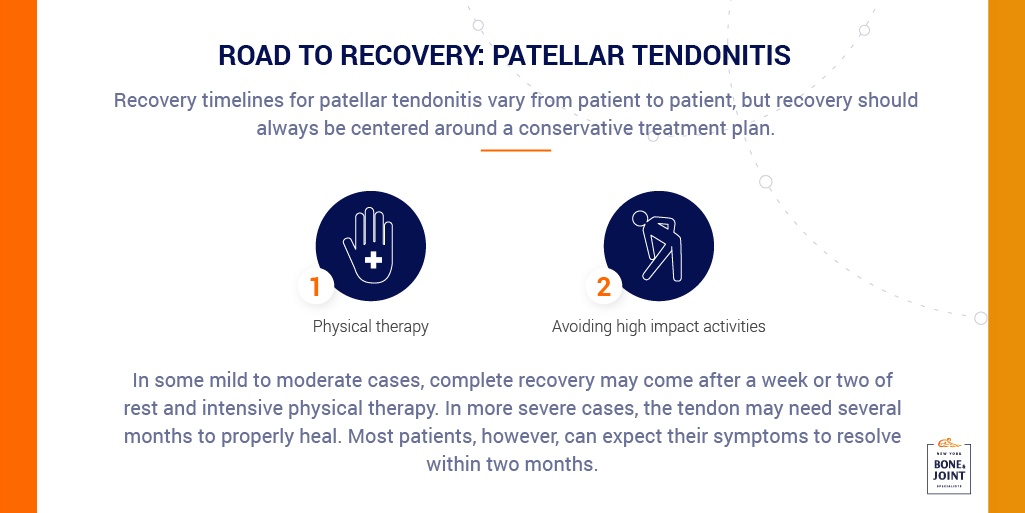WHAT IS PATELLAR TENDONITIS?
Patellar tendonitis is an inflammation of the patellar tendon, the piece of connective tissue that joins the kneecap and the shin. Often referred to as “jumper’s knee,” the condition is most commonly caused by prolonged stress or overuse of the tendon, but in rare cases, it can be the product of acute trauma. Jumper’s knee most often occurs in sports that require frequent bending and flexing of the knee, such as basketball and volleyball, but the condition can affect anybody.
PATELLAR TENDONITIS SYMPTOMS
The most common symptom of patellar tendonitis is a burning pain around the kneecap. Some patients also experience stiffness, redness, and, in rare cases, swelling in the joint. These symptoms become more pronounced when attempting to bend or extend the knee.
PATELLAR TENDONITIS TREATMENT

Patellar tendonitis can be diagnosed with a simple physical examination. After locating the injury, your orthopedic specialist will likely take an X-ray to locate any bone spurs or other skeletal defects that might be responsible for the inflammation, as well as an MRI to evaluate any degeneration in the patellar tendon.
Like most forms of tendonitis, patellar tendonitis can be effectively treated with some conservative measures. Aside from resting the knee and refraining from running and jumping, icing, anti-inflammatories, and physical therapy can all promote a quicker recovery by alleviating pain and swelling. Some patients may also benefit from iontophoresis, a treatment in which a topical corticosteroid medication is applied to the joint. After the inflammation subsides, regularly stretching the knee and wearing a supportive brace or strap can strengthen and reinforce the tendon, reducing the risk of future irritation.
These conservative courses of treatment should provide mild to significant relief within several days, and most cases of patellar tendonitis should resolve completely in three to four weeks. Depending on the extent of the damage, however, complete recovery may require as long as six to eight months.
PATELLAR TENDONITIS SURGERY AND RECOVERY TIME
Surgery
While most symptoms of patellar tendonitis can be resolved with the conservative treatments described above, some rare cases may need to be treated surgically. While surgeons have historically relied on open surgery to remove the damaged portions of the tendon and mend any tears in it, arthroscopic surgery is becoming an increasingly common alternative. Your orthopedic surgeon will choose the appropriate course of action based on your specific injury, guiding you through every step of the procedure and recovery process.
Surgery Recovery Time
Recovery timelines for surgically repaired patellar tendons vary from patient to patient. If complemented by a rigorous physical therapy program, complete recovery may come in as little as a week or two for mild to moderate cases. Meanwhile, more severe cases may require several months for the tendon to properly heal.
_________________________________
EXPERIENCING PAIN? DO YOU HAVE AN INJURY?
Our Specialists are here to help.
Book an appointment with NYC’s best orthopedic specialists to discuss your condition. Fill out the form below and you will receive a call from our office within 5-10 minutes. We’ll book an appointment at a time and location that work for you, and send you a reminder by email.
Frequently Asked Questions About Patellar Tendonitis
How long does it take for patellar tendonitis to heal?
Recovery time for patellar tendonitis varies based on the severity of your condition and how quickly you begin treatment. Mild cases typically improve within 3-4 weeks with proper rest and conservative treatment including ice, anti-inflammatory medications, and activity modification. However, moderate to severe cases can take 6-8 months or longer to heal completely, especially if the condition has become chronic.
The key to faster recovery is catching the problem early and consistently following your treatment plan. This includes avoiding activities that aggravate the tendon (jumping, running, squatting), attending physical therapy sessions, and gradually returning to activity only when cleared by your doctor.
If you try to return to sports or intense activity too soon, you risk re-injury and prolonging your recovery. Chronic patellar tendonitis that has persisted for months may require more aggressive treatments or, in rare cases, surgery, which can extend recovery to several months.
What’s the best treatment for jumper’s knee?
The most effective treatment for jumper’s knee (patellar tendonitis) starts with conservative measures that address both pain relief and the underlying cause. Initial treatment focuses on reducing inflammation through rest from aggravating activities, ice application for 15-20 minutes several times daily, and over-the-counter anti-inflammatory medications. Once the acute pain subsides, physical therapy becomes crucial for long-term recovery.
Your physical therapist will guide you through exercises that strengthen the quadriceps and hamstring muscles, improve flexibility, and correct any movement patterns that may have contributed to the injury.
Eccentric strengthening exercises, where you slowly lower weight against resistance, have shown particularly good results for patellar tendonitis. A patellar tendon strap or brace worn just below the kneecap can provide support and reduce stress on the tendon during activities. Some patients benefit from iontophoresis, a treatment that uses electrical current to deliver anti-inflammatory medication directly to the affected area. Surgery is rarely needed but may be considered if conservative treatments fail after 6-12 months.
Can you still exercise with patellar tendonitis?
You can exercise with patellar tendonitis, but you need to modify your activities to avoid aggravating the condition. Complete rest isn’t usually recommended as it can lead to weakness and stiffness, but you should avoid high-impact activities that stress the patellar tendon, such as jumping, running, deep squatting, and sports involving sudden starts and stops. Instead, focus on low-impact exercises like swimming, cycling on flat terrain, or using an elliptical machine, which maintain your cardiovascular fitness without overloading the tendon.
Upper body strength training is also safe and beneficial. As your symptoms improve with treatment, you can gradually reintroduce impact activities under your physical therapist’s guidance, starting with low-intensity movements and slowly progressing.
Pay attention to pain levels—mild discomfort may be acceptable, but sharp pain or pain that persists after exercise means you need to reduce intensity or volume. Working with a physical therapist ensures you maintain fitness while allowing proper healing.
What causes jumper’s knee and who is at risk?
Jumper’s knee develops when repetitive stress and overuse cause small tears and inflammation in the patellar tendon, the strong tissue connecting your kneecap to your shinbone. The condition gets its name because it’s especially common in athletes who perform frequent jumping activities like basketball, volleyball, and track and field, though it can affect anyone.
Risk factors include sudden increases in training intensity or volume, participating in sports on hard surfaces, tight leg muscles (particularly quadriceps and hamstrings), muscle imbalances or weakness, poor jumping or landing technique, and previous knee injuries.
Weekend warriors who suddenly increase activity after periods of inactivity are also at higher risk. In New York City, we often see jumper’s knee in recreational athletes who play intense pickup basketball games, gym-goers who overdo plyometric exercises, or runners who rapidly increase mileage. Age is also a factor—the condition most commonly affects people in their teens through thirties when they’re most active in sports. Prevention strategies include proper warm-up routines, gradual training progression, maintaining leg strength and flexibility, and using proper technique during sports and exercise activities.












